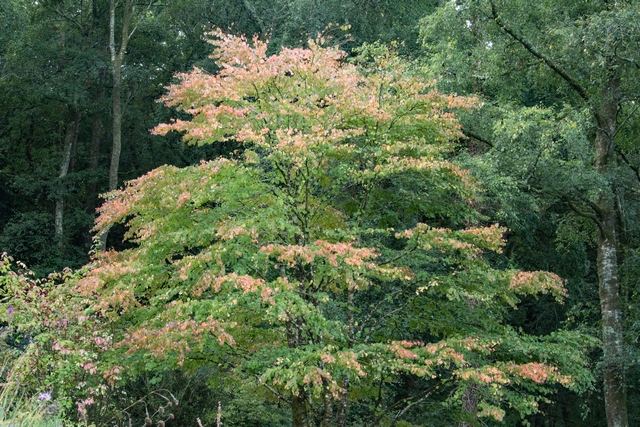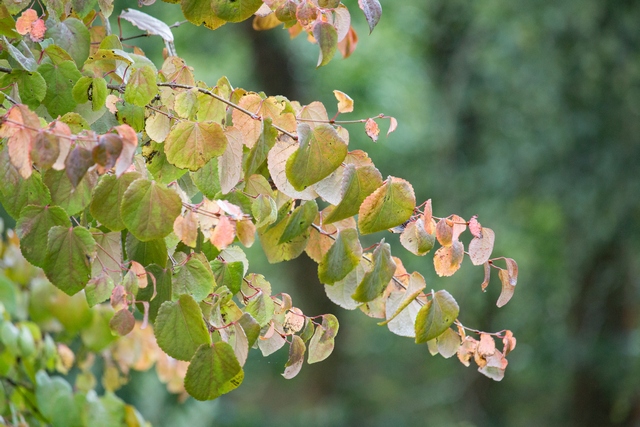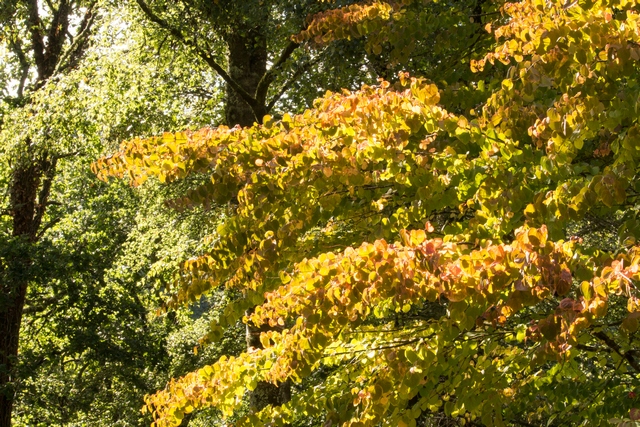A garden without seasons must be such a dull place. Winter turns to spring, spring to summer, summer to autumn and autumn to winter; without the comings and goings of various plants a garden would somehow be without soul.
As summer gracefully gives way to autumn we enter a time of the year when deciduous trees come into their own. At ground level we are delighted by asters, grasses and other late season treats, but above our heads the towering trees mark the change of season by changing into their autumn colours.
Acers, Liriodendrons, Nyssas and Liriodendrons, to name a few, are stars of the autumn garden, but I would like to discuss a slightly less well known tree, Cercidiphyllum japonicum.
Originally it was thought that this species was confined only to Japan, but Wilson found it growing in China in 1910… well, he found one tree! Since then others have found this species in China, including Roy Lancaster who saw trees on Emei Shan in 1980. Quite whether Wilson wasn’t looking very hard or the tree had propagated itself during the 70 years between Wilson and Lancaster’s explorations of Emei Shan is unclear, I’m inclined to think the former, but Lancaster found “among several specimens seen on the mountains… a tree of some 25m (82ft) with three stems.” For a while the Chinese forms were regarded as being C. japonicum var. sinense, but over the years this has seemed less and less plausible and is regarded as an invalid name.
In the wild C. japonicum reaches around 30m (100ft) in height (W.J. Bean 1980, G. Krussmann 1984), although none in cultivation have reached quite that size. There was a sizeable tree outside the walled garden at Knightshayes Court in Devon, UK, but it had been felled by the last time I visited. By no stretch of the imagination is this a tree for a small garden, with even fairly young trees spreading out as they develop. This is, however, an undeniably nice tree and well worth growing if you have the space, and also worth seeking out in gardens and arboreta if you don’t.

Initially the growth rate of a young C. japonicum can seem alarming, but once they’ve made a sensibly sized tree they calm down a bit! There is a belief that they prefer shade, but to be honest they seem happy enough in sun in my region (maritime temperate, USDA z8). Maybe the desire for shade is more in areas where there isn’t as much rainfall; Cercidiphyllums strongly dislike drying out, so it would make sense.

With insignificant flowers, Cercidiphyllum japonicum is overwhelmingly a tree for autumn. In the earlier days of growing them it was suggested that the ‘var. sinense’ turned red in autumn while the Japanese species turned yellow, but this has been disproved.
“One never knows when Cercidiphyllums are going to turn or what colour they will assume. Here they are seldom all red or all yellow, but generally assume shades of red, orange, pale yellow, pale pink, mauve and green.”
Mark Fenwick, Abbotswood, Gloucestershire (RHS Journal Vol. 65, 1940, p.167)
Of course if trees are hidden away in shade then the autumn shades are muted, as you can see if you compare the two photographs above, taken when the tree was shaded, with the following taken when the tree was bathed in late afternoon sunlight.

The pièce de résistance of this species is the smell; as the leaves change color and fall they give off a strong scent of burnt sugar! Whatever you do, don’t rush to tidy up the fallen leaves!
There are several cultivars of C. japonicum around;
C. japonicum var. magnificum- very similar to the straight species but with slightly larger, more rounded leaves. Nice, but then so is the straight species…
C. japonium ‘Pendulum’- a gracefully weeping form. Krussmann said that it has been “in culture for over 300 years at a Buddhist Temple on Honshu Island, Japan, and [is] considered a natural monument.”
C. japonicum ‘Morioka Weeping’- this form has a stronger habit than ‘Pendulum’, and is arguably the better pendulous form. Typically it can be a total pain to track it down!
C. japonicum ‘Rotfuchs’- a variety I’ve somewhat fallen out with. An upright form with dark purple foliage which is regarded as being more resistant to frost. However it is prone to losing its dark colour if it gets too warm; given that I’ve seen trees change even in a fairly unexceptional British summer I’m inclined to think they have really poor heat tolerance.
Michael Dirr, in his Encyclopedia Of Trees And Shrubs, lists several clones that I’ve certainly not seen in the UK; ‘Heronswood Globe’, ‘Peach’, ‘Raspberry’ and ‘Ruby’. Given that the last three were named for their reliable autumn colours you wonder if a more continental climate makes the autumn colours more predictable?
Dirr also lists C. japonicum ‘Pendulum’ as a variety called ‘Amazing Grace’, but I don’t think this name has been widely accepted in the UK.
If you are lucky enough to have a fairly evenly damp soil, reasonable shelter and a lack of damaging late frosts, Cercidiphyllum japonicum is a very worthwhile tree.
If you have enough room for one…


